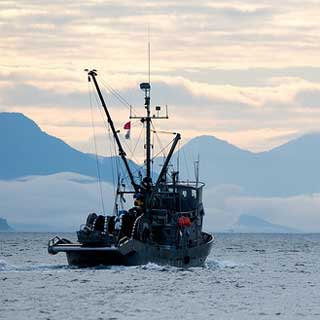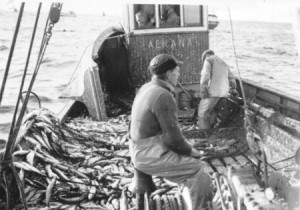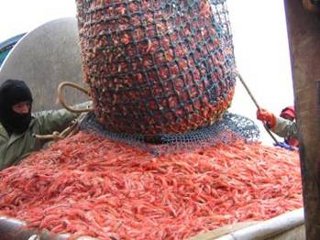Commercial fishing is a worldwide enterprise that involves the capture of marine and freshwater fish and shellfish and their preparation for market. Fishing equipment ranges from small boats whose nets are cast and hauled in by hand to factory ships equipped with the most advanced technologies for finding, harvesting, and preparing huge amounts of fish. These large catches are very costly, however, not only in the price of their equipment and fuel, but also in the depletion of fishery resources their use brings about.
The major portion of the total fish harvest consists of few fish species, which are divided into two primary groups. Pelagic species – those which  live in the near-surface layers of the oceans, this includes several species of herring, tuna, salmon, anchovies, pilchard, sardines, menhaden, and mackerel. Demersal species – fish that live in the near-bottom layers of the ocean, this includes cod, sole, halibut, haddock, hake, and flounder. Large catches are also made of a group of fish classed commercially as SHELLFISH – shrimp, lobster, scallops, oysters, clams, crabs, mussels, and squid. WHALING was once a major part of the fishing industry. Overfishing has endangered many whale numbers, however, and the field has lessened in importance.
live in the near-surface layers of the oceans, this includes several species of herring, tuna, salmon, anchovies, pilchard, sardines, menhaden, and mackerel. Demersal species – fish that live in the near-bottom layers of the ocean, this includes cod, sole, halibut, haddock, hake, and flounder. Large catches are also made of a group of fish classed commercially as SHELLFISH – shrimp, lobster, scallops, oysters, clams, crabs, mussels, and squid. WHALING was once a major part of the fishing industry. Overfishing has endangered many whale numbers, however, and the field has lessened in importance.
Almost all large pelagic and demersal fish catches are made over or near the continental shelf, the underwater plateau around the continents and large islands. In these waters temperatures, water depths, and the currents that influence the amounts of available food to create an environment that is highly favorable to the existence of large schools of fish.
The animals living in and on the bottom of the continental shelf serve as additional food sources for demersal fish. Also, most species spawn on continental shelves, and the main nursery grounds of many species are also in coastal regions. The main fishing grounds are located on the wider continental shelves of the mid and high latitudes. The single most important area is the North Pacific, whereas much as one-quarter of the world’s fish catch is taken.
Development of the Fishing Industry
Prehistoric people were hunters and food collectors, and they found much of their food in lakes, rivers, and shallow coastal ocean waters. Shellfish were the most accessible food, and the large shell heaps found around the first fishing technique, the use of bare hands.
During 10,000-6000 BC, certain cultures that depended almost entirely on a diet of fish developed primitive fishing technologies. The Scandinavian Maglemosian culture used stone-pointed fishing spears, antler and bone harpoons and fishhooks, and lines and nets woven of bark fiber. Improved equipment increased the size of catches, and preservation techniques were developed for drying, smoking, salting, and  pickling fish. As larger boats were built, fishing craft adventured farther into the oceans, and sea fishing developed into a well-defined business, with settlements whose main occupation was catching fish.
pickling fish. As larger boats were built, fishing craft adventured farther into the oceans, and sea fishing developed into a well-defined business, with settlements whose main occupation was catching fish.
Early ocean fisheries were confined to the coastal regions of settled areas and to the Mediterranean Sea, which had been the traditional fishing grounds for large numbers of fish species, especially tuna. Slowly, the rich fishing regions of the Atlantic Ocean and the North and Baltic seas began to be exploited. The opening of these new fishing grounds had a significant influence on the spread of trade during the Middle Ages and on the establishment of new trade routes – for example, the herring fisheries in the southern Baltic and North seas that helped to establish the HANSEATIC LEAGUE.
The opening of the fishing areas around Nova Scotia and Newfoundland had a serious effect on European history. First fished by the French in the early 1500s, by the beginning of the 17th century the North Atlantic fisheries had become the main source of New World wealth for England.
Principal Fisheries
The most important world fisheries are located in waters less than 400m in depth. Major fishing grounds are in the North Atlantic including the GRAND BANKS and the Georges Banks off the New England coast, the North Sea, the waters over the continental shelves of Iceland and Norway, and the Barents Sea; in the North Pacific, specifically the Bering Sea, the Gulf of Alaska, and the coastal areas around Japan; and off the coasts of China and Malaysia. Other important fishing grounds are found off the coasts of the southeastern United States, Chile, Peru, Argentina, and the Falkland Islands, and off the coasts of Namibia and South Africa.
More than one-half of the marine fish catch in the United States is taken in the Northeast Pacific and in Alaskan coastal waters. In 1993 the total of all the Atlantic fisheries given slightly more than 18 percent, with the Gulf of Mexico fishery adding another 16 percent. Pollock, shrimp, sockeye salmon, and snow crab are the most valuable catches – and these, with the exception of shrimp, are all Northeast Pacific fish. Haddock landings off the New England coast decreased in the 1980s because of overfishing. The cod fishery in the Northeast Atlantic collapsed in the early 1990s for the same reason.
The profitable king crab fishery in the Bering Sea broke down in the 1980s, and much of the crab fleet was changed to trawlers, which yielded higher catches of Pacific cod and pollock in joint venture fisheries with foreign processors, who were mainly Japanese and Russian.
The local fisheries of the African coast, and many of those found elsewhere in the tropics, remain undeveloped. The main limiting factors are: first, the narrowness of the continental shelf, which doesn’t allow the numbers of demersal fish, and the existence of a straight coastline that doesn’t offer many possibilities for good harbors; second, the high temperatures, which affect the keeping quality of the fish catch; and third, limited access to the interior, making marketing difficult. Fish landings from these areas are usually dried, smoked, or salted immediately.
Fish Harvesting
The standard methods of catching fish involve either nets, hooked lines, or traps. Pelagic fish are most often harvested using purse seine nets,  which are set in a wide circle around the school of fish and then closed and drawn up. Straight drift or gill nets – whose mesh is just large enough to allow the heads of fish to pass through while trapping them at their gills – are used to catch salmon, tuna, cod, and other fish. Demersal fish may be caught in otter trawl nets pulled along the ocean bottom or netted with beam trawls that are used in more shallow waters, mainly for shrimp.
which are set in a wide circle around the school of fish and then closed and drawn up. Straight drift or gill nets – whose mesh is just large enough to allow the heads of fish to pass through while trapping them at their gills – are used to catch salmon, tuna, cod, and other fish. Demersal fish may be caught in otter trawl nets pulled along the ocean bottom or netted with beam trawls that are used in more shallow waters, mainly for shrimp.
In halibut fishing, hooked ground lines, called long lines, may reach lengths of many miles, with baited hooks attached at intervals of 6 to 9 m. Floating long lines are used primarily in tuna and salmon fishing, and so are trolling lines, shorter lines towed behind a moving boat. Lights may be lowered into fresh waters to attract fish, which are then sucked up into the ship by vacuum pumps
Beginning in the early 1980s, Japanese, Taiwanese, and South Korean fishing fleets began to use a new fishing technique to make large-scale squid catches in the North Pacific. Huge, 15m deep drift nets made of unbreakable nylon, each stretching 90 m, were lowered off the boats each evening. Together, the nets from a single boat formed a great wall just under the surface of the ocean. The nets drifted all night, catching any sea creatures that happened to swim into their meshes – not only the squid, but amounts of other fish and ocean mammals such as dolphins and seals. Drift-net assemblies began to be used to make catches of other commercial fish in addition to squid. The accidental catch, called “by-catch” in the trade, was thrown away. Large-scale drift-net fishing declined after a UN resolution that went into effect in 1993.
Fish Processing
Fishing vessels that make their catches close to port store fish in crushed ice or in refrigerated sea water. Large fishing vessels on long trips are equipped to keep their catch edible by storing it in refrigerated facilities or by quick-freezing it. A fully equipped factory ship will also have machinery on board for fish filleting and freezing or canning. Fish fillets are frozen at sea into large blocks weighing up to 45 kg, these are later reprocessed on shore into individual portions. Some ships may also have facilities for drying and grinding fish into fish meal.
